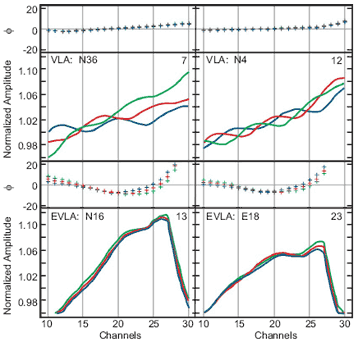NRAO eNews
October 2008 • Vol. 1, Iss. 5
- The Expansion of Supernova Remnant G21.5–0.9: Is PSR J1833–1034 the Youngest Pulsar?
- Discovery of a Small Group Driving the Evolution of an Edge-On Spiral Galaxy
- Cosmic Rays and the Magnetic Field in the Nearby Starburst Galaxy NGC 253
- Neutral Hydrogen Clouds in the M81/M82 Group
- ALMA Project Progress
- North American ALMA Science Center
- The ALMA Spectral Line Catalog
- The Birth and Feedback of Massive Stars, Within and Beyond the Galaxy: The NAASC Science Workshop for 2008
- Current Status
- VLA Configuration Schedule, Proposals, and Scheduling
- VLBA and HSA Proposals and Scheduling
- Global cm VLBI Proposals
- VLA and EVLA Spectral Line Observations Below 1200 MHz
- Status of Observing with the Transition Array
- VLBA Sensitivity Upgrade Project
- First 3mm Science Observations with the GBT and MUSTANG Call for Proposals
- The GBT Dynamic Scheduling System Update
- Progress on the Ka-Band Focal Plane Array for the GBT
- Opportunities for University-Led Technical Development Projects in Green Bank
- New NRAO Website Debuts
- The NRAO at the American Astronomical Society and American Association for the Advancement of Science Meetings
- Call for GBT Shared-Risk MUSTANG Proposals
- Large Proposals to Use NRAO Telescopes
- Chris Carilli Appointed Observatory Chief Scientist
- Eleventh Synthesis Imaging Workshop
- 2008 Grote Reber Medal Awarded to Sandy Weinreb
- NRAO Participates in the BEYA Conference
- NRAO Business Managers Meet in Chile
- NRAO Library News
- Past Issues
- Contact the Editor
- Subscribe
- More Information
NRAO Newsletter • April 2008 • Issue 115
Status of Observing with the Transition ArrayAs this newsletter goes to press, there are 14 fully functioning EVLA antennas in the array, which means that for the first time retrofitted EVLA antennas outnumber the old VLA antennas. During the last few months a number of improvements of interest to observers have taken place:
The main problem currently still with us, affecting mainly narrow bandwidth spectral line observations, is the aliasing of emission around baseband. This affects data on EVLA—EVLA baselines in the lowest 0.7 MHz of the total bandwidth (or the highest 0.7 MHz for X- and U-Band). In some cases the line emission can be recovered by applying the AIPS task UVLSF which has been adapted especially for this purpose, but requires at least 50 percent of the spectral line channels to be line-free. The problem is even more serious when the line emission of interest continues below baseband. This means any continuum emission cannot be reliably recovered; it also compromises stitching together line data from two IF pairs partially overlapping in frequency. In January 2008, it was discovered that small frequency differences between source and calibrator (e.g. of the kind normally introduced by Doppler tracking on both with the same velocity) causes phase changes, which make it impossible to apply calibrator solutions to the source. A fix to this problem is currently being implemented. Until this is thoroughly tested, source and phase calibrator must be observed at the same frequency, i.e., observers should not use Doppler tracking. 
Figure 1. Normalized amplitude and phase bandpass solutions for VLA Antennas 7 and 12 (top panels) and EVLA Antennas 13 and 23 (bottom panels), for three observing frequencies: 8448 MHz (green), 8450 MHz (blue), and 8452 MHz (red). In each case the total observing bandwidth is 12.5 MHz. Bandpasses, on the other hand, are much more insensitive to frequency differences for EVLA antennas than they are for VLA antennas, as the latter are affected by standing waves in the waveguide. This is illustrated in Figure 1, which shows the normalized bandpass amplitudes and phases at X-band for two VLA antennas and two EVLA antennas over 12.5 MHz total bandwidth for observing frequencies 8448 MHz (green), 8450 MHz (blue), and 8452 MHz (red). Note the variation (the “3 MHz ripple”) in VLAAntennas 7 and 12, and the much more stable behavior for EVLA Antennas 13 and 23. Our first tests indicate that EVLA bandpasses are equally stable at other bands as well. For the latest news on these and other items, please consult our EVLA returns web page. G. van Moorsel and C. Chandler |
